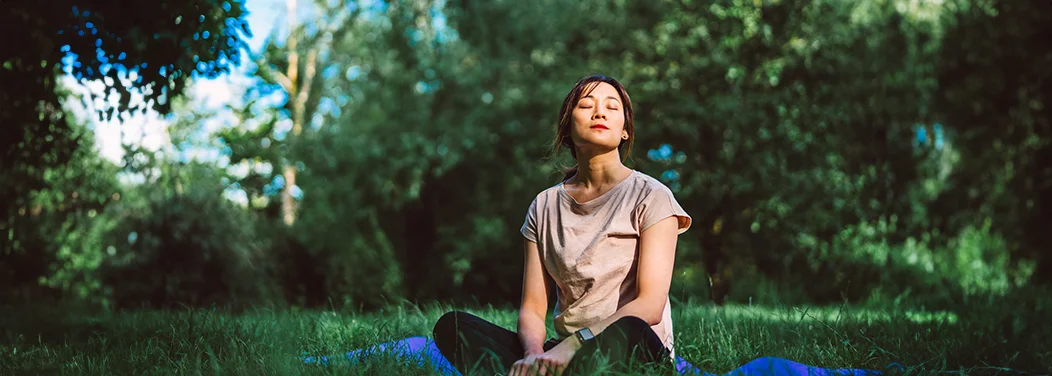Topics
Anxiety and stress can feel overwhelming. However, finding calmness and relief might be closer than you think. Breathing exercises are designed to ease anxiety and alleviate stress. These techniques, rooted in mindfulness, offer a pathway to serenity amidst life’s chaos.
From simple deep breathing methods to structured patterns, each exercise empowers you to regain control and find peace within. Embrace these techniques to soothe your mind, calm your nerves, and cultivate a sense of tranquillity in your daily life.
What are the signs and symptoms of stress and anxiety?
Stress and anxiety exhibit a multitude of signs and symptoms, ranging from physical manifestations like increased heart rate and muscle tension to emotional indicators such as worry and irritability. These symptoms often accompany one another, creating a complex web of effects on both mental and physical well-being.
Sleep disturbances, changes in appetite, and fatigue are common. Additionally, individuals may contend with racing thoughts, excessive sweating, or gastrointestinal discomfort, further amplifying the overall impact on their daily lives.
By acknowledging these symptoms, individuals can take proactive steps to manage and alleviate the consequences of stress and anxiety on their mental and physical health. This recognition empowers individuals to seek the appropriate resources and support systems to navigate these challenges effectively.
How does breathing help anxiety and stress?
Breathing exercises help relieve anxiety and stress by activating the body’s relaxation response. Deep breathing increases oxygen supply, calming the nervous system and decreasing the production of stress hormones like cortisol.
This practice encourages mindfulness, shifting focus to the present moment. Regular deep breathing enhances emotional regulation, lowering anxiety levels and fostering a sense of control.
What are the breathing exercises for anxiety and stress?
Discover powerful breathing exercises tailored to alleviate anxiety and stress. These techniques, ranging from deep breathing to mindful practices, offer effective ways to calm the mind and body, relieving overwhelming emotions.
1. Long exhale
The long exhale technique is a potent breathing exercise to combat anxiety and stress. Extending the exhale phase longer than the inhale stimulates the body's relaxation response.
This practice encourages a more release of carbon dioxide, triggering the parasympathetic nervous system to calm the body. Begin by inhaling slowly through the nose, then exhale gradually, aiming for a longer duration than the inhale.
The extended exhale lowers heart rate, decreases blood pressure, and eases muscle tension. The exercise fosters mindfulness, redirecting focus from stressors to the breath, promoting a sense of calm and control amid anxiety and stress.
2. Alternate nostril breathing
Alternate nostril breathing, a revered pranayama technique in yoga, offers a powerful remedy for anxiety and stress. The exercise involves gently closing one nostril while inhaling through the other, then switching sides to exhale. Follow these steps:
- Sit comfortably with your spine erect, using your right thumb to close your right nostril and your ring finger or pinky to close your left nostril.
- Block the right nostril and take a breath through the left nostril.
- Block the left nostril, open the right, and release the breath through the right nostril.
- Inhale using the right nostril, seal it and exhale through the left nostril.
- Continue this alternate pattern.
This rhythmic breathing balances the brain's hemispheres, enhancing cognitive function and reducing stress. It promotes a sense of harmony and balance within the mind and body.
3. Belly breathing (Diaphragmatic breathing)
Belly breathing, or diaphragmatic breathing, is a potential technique for relieving anxiety and stress. This technique involves deep inhalation, expanding the belly as the diaphragm descends, allowing maximum oxygen intake. Practise belly breathing using the following steps:
- Find a comfortable seated or reclined posture, with one hand resting on your chest and the other on your abdomen.
- Inhale gently through your nostrils, allowing your belly to expand as your lungs breathe.
- Exhale through your mouth, letting the air out gently, feeling your belly fall as you release the breath.
It triggers the body's relaxation response by activating the parasympathetic nervous system, reducing cortisol levels and heart rate. This exercise cultivates a sense of calmness, releases muscle tension, and promotes mental clarity.
4. The humming breath
The humming breath, or Bhramari pranayama3, is a calming technique for anxiety and stress. The practice involves inhaling deeply and exhaling slowly while humming, akin to a bee's gentle buzz.
The vibration created by this sound stimulates the vagus nerve, causing a relaxation response in the body. This exercise reduces stress hormones, inducing a sense of tranquillity. The soothing resonance of the humming breath soothes the mind, offering a respite from racing thoughts.
Its rhythmic nature encourages focus and mindfulness, redirecting attention away from stressors. Incorporating the humming breath into a routine provides a serene space amidst chaos, fostering mental peace and emotional balance.
5. 4-4-4 breathing
The 4-4-4 breathing technique is a structured practice for anxiety and stress. It involves inhaling for four counts, holding for four counts, and exhaling for four counts. The method synchronises breath with a pattern, promoting relaxation. To practise this, you can:
- Find a quiet space and sit comfortably, focusing on your breath.
- Breathe in via your nostrils, counting to 4.
- Pause and hold your breath for another count of 4.
- Exhale through your mouth steadily, counting to 4, maintaining a steady rhythm throughout.
Regulating the breath reduces the heart rate and calms the nervous system. This exercise enhances oxygenation, supports clearer thinking, and reduces tension. Its rhythmic nature aids in mindfulness, anchoring attention to the present moment and alleviating anxious thoughts.
6. 4-7-8 breathing
The 4-7-8 breathing control is a renowned antidote for sleep deprivation, anxiety and stress, involving inhaling for four counts, holding for seven, and exhaling for eight. This practice regulates the breath, inducing a deep state of relaxation. Practise this technique by:
- Sit or lie down comfortably, ensuring good posture.
- Breathe in softly through your nostrils, counting to 4.
- Hold your breath while counting to 7.
- Exhale audibly through your mouth, making a 'whoosh' sound, counting to 8 as you release your breath.
7. Resonant breathing
Resonant breathing, or coherent breathing, helps relieve anxiety and stress. This technique involves inhaling and exhaling at about five to six breaths per minute, creating a resonance between the heart rate and breathing rhythm. Practise resonant breathing by:
- Sit or lie down comfortably, ensuring relaxation and good posture.
- Inhale and exhale gently, aiming for a steady pace of about five to six breaths per minute.
- Focus on maintaining a consistent rhythm, allowing the breath to flow naturally without force.
Syncing these rhythms activates the body’s relaxation response, reducing stress hormones and promoting a balanced nervous system.
8. Lion’s breath
The Lion's breath technique, a distinctive yogic practice, offers a playful yet practical approach to combat anxiety and stress. This exercise involves inhaling deeply and then forcefully exhaling through the mouth while sticking out the tongue and roaring soundlessly.
The dynamic release of breath activates the throat and facial muscles, releasing tension and pent-up emotions.
This playful exercise promotes a sense of empowerment and liberation, reducing anxiety by releasing stored tension. Incorporating Lion's Breath into a routine offers a cathartic release, easing stress and inviting a renewed sense of lightness and ease in the body and mind.
9. Mindfulness breathing
Mindfulness breathing, a cornerstone of meditation, acts as a potent remedy for anxiety and stress. This practice centres on observing the breath without altering its natural rhythm, anchoring attention to the present moment.
Focusing on each inhale and exhale cultivates awareness, detaching from anxious thoughts and emotions. This exercise promotes a non-judgmental attitude, allowing acceptance of present sensations. Mindfulness breathing enhances self-regulation, calming the nervous system and reducing the physiological impacts of stress.
Regular practice fosters resilience, creating a space for introspection and emotional balance. Its simplicity and adaptability make mindfulness breathing versatile, empowering individuals to navigate anxiety and stress with newfound clarity and composure.
10. Pursed-lip breathing
Pursed-lip breathing is a therapeutic technique beneficial for anxiety and stress. In this technique, breathe in through your nose and release the breath gradually through pursed lips, mimicking the action of blowing out a candle. Creating a slight resistance to air outflow extends exhalation, regulating breathing patterns.
This method enhances oxygen exchange, reducing breathing effort and calming the mind. It stabilises breathing rates, decreasing feelings of breathlessness often associated with anxiety.
It relaxes the body, lowering heart rate and promoting relaxation. This technique is easily adaptable and provides immediate relief, making it a valuable tool for managing anxiety and stress in various situations.
When to see a doctor for stress and anxiety?
Recognising when stress and anxiety significantly impact your daily life and functioning is essential. While occasional stress is normal, persistent or overwhelming feelings of anxiety may warrant professional help.
If symptoms interfere with daily life, physical symptoms persist, there are sleep disturbances or suicidal thoughts, prompt medical attention is crucial for appropriate evaluation and support.
Make an appointment at Pantai Hospitals
In the pursuit of calmness amidst life’s chaos, these breathing exercises are potent tools to combat anxiety and stress. From the calming embrace of the long exhale to the rhythmic balance of alternate nostril breathing, each technique offers a pathway to reclaiming control and fostering tranquillity within.
By harnessing the power of breath, these exercises not only alleviate the physical manifestations of stress but also empower the mind, providing strategies to navigate the tumultuous currents of anxiety.
Contact the Health Screening Centre if you are looking for health screening packages or get in touch with us to book an appointment today for a consultation with the team of clinical psychologists at your nearest Pantai Hospital.
Pantai Hospitals have been accredited by the Malaysian Society for Quality in Health (MSQH) for its commitment to patient safety and service quality.













